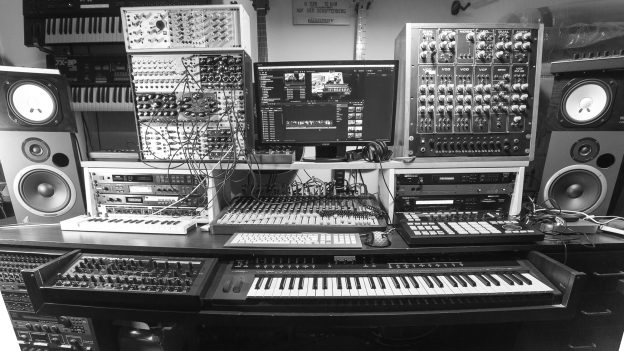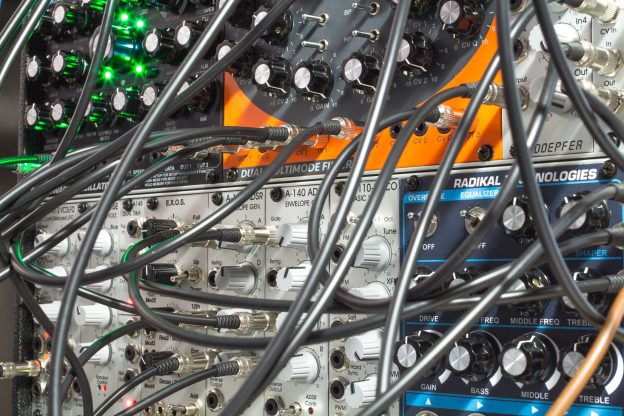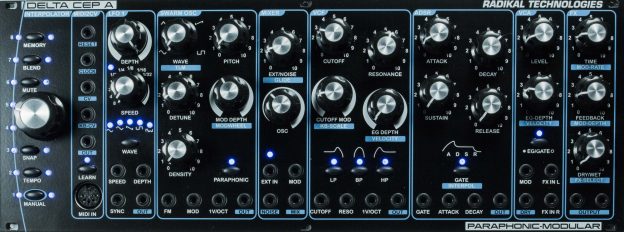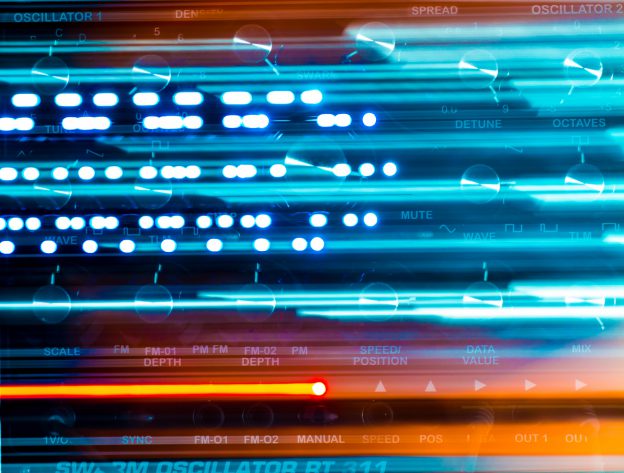Setting up some sounds and start jamming and improvising. I am using the Accelerator, the Spectralis II, a Yamaha DX7II (via keystep) a Roland D550 (via keystep) and the Delta CEP A together with the Doepfer Stepsequencer A155.


Setting up some sounds and start jamming and improvising. I am using the Accelerator, the Spectralis II, a Yamaha DX7II (via keystep) a Roland D550 (via keystep) and the Delta CEP A together with the Doepfer Stepsequencer A155.

![]() I created a modular patch to create some random signals. I just wanted to know, what I can create out of random signals with a little help of the EFFEXX module. I created the random signal, that is audible at the very beginning of the file with the delta CEP A and a Sample and Hold Module (Doepfer A148). The LFO of the Delta clocks the Sample and Hold Circuit. Gate signal must have a minimum voltage. I thought, if I apply noise at the input of the sample and hold circuit, I will get a random voltage that is sometimes above the minumum level and sometimes below. That creates my random triggers. I fed the Sample and Hold output into the Gate trigger input of the envelope. I am feeding the oscillator or noise into the filter and program a very short envelope to create this short noise bursts. From there I go directly into the EFFEXX and from there to my recording mixing desk. I am using Reverb, the String Filter, the Pitch Shifter and the post Lowpass filter for this patch.
I created a modular patch to create some random signals. I just wanted to know, what I can create out of random signals with a little help of the EFFEXX module. I created the random signal, that is audible at the very beginning of the file with the delta CEP A and a Sample and Hold Module (Doepfer A148). The LFO of the Delta clocks the Sample and Hold Circuit. Gate signal must have a minimum voltage. I thought, if I apply noise at the input of the sample and hold circuit, I will get a random voltage that is sometimes above the minumum level and sometimes below. That creates my random triggers. I fed the Sample and Hold output into the Gate trigger input of the envelope. I am feeding the oscillator or noise into the filter and program a very short envelope to create this short noise bursts. From there I go directly into the EFFEXX and from there to my recording mixing desk. I am using Reverb, the String Filter, the Pitch Shifter and the post Lowpass filter for this patch.
![]() Für diese Demo habe ich geschaut, was man so aus einer zufälligen Abfolge von Signalen herausholen kann, wenn ich sie durch den EFFEXX schicke. Man hört zu Anfang das Ursprungssignal, das ich mit dem Delta CEP A und einem Doepfer A148 Sample and Hold Modul erzeugt habe. Für das Random Signal mache ich mir zu nutze, dass man eine gewisse Mindestspannung benötigt, um eine Hüllkurve per Gate Eingang zu triggern. Von daher takte ich die Sample und Hold Schaltung mit dem LFO und lege am Eingang den Rauschausgang des Delta CEP A an. Am Ausgang des Sample & Hold Moduls kann man sofort erkennen, dass nun positive und negative Spannungen erzeugt werden. Die positiven triggeren die Hüllkurve sofern sie über 2.5 Volt liegen. Die negativen und kleineren Spannungen triggeren die Hüllkurve nicht. Die Hüllkurve wird sehr kurz eingestellt. Ich habe das Signal ausgedünnt, in dem ich das Bandpass-Filter verwende.
Für diese Demo habe ich geschaut, was man so aus einer zufälligen Abfolge von Signalen herausholen kann, wenn ich sie durch den EFFEXX schicke. Man hört zu Anfang das Ursprungssignal, das ich mit dem Delta CEP A und einem Doepfer A148 Sample and Hold Modul erzeugt habe. Für das Random Signal mache ich mir zu nutze, dass man eine gewisse Mindestspannung benötigt, um eine Hüllkurve per Gate Eingang zu triggern. Von daher takte ich die Sample und Hold Schaltung mit dem LFO und lege am Eingang den Rauschausgang des Delta CEP A an. Am Ausgang des Sample & Hold Moduls kann man sofort erkennen, dass nun positive und negative Spannungen erzeugt werden. Die positiven triggeren die Hüllkurve sofern sie über 2.5 Volt liegen. Die negativen und kleineren Spannungen triggeren die Hüllkurve nicht. Die Hüllkurve wird sehr kurz eingestellt. Ich habe das Signal ausgedünnt, in dem ich das Bandpass-Filter verwende.
Am Anfang der Audio Datei hört man das Resultat, dass dann in das EFFEXX Modul eingespeist wird. Im EFFEXX Modul benutze ich im Verlaufe der Demo die folgenden Effekte:
String-Filter, Pitch Shifter, Reverb und Post Lowpass Filter. Ich habe eine serielle Abfolge der Effekte gewählt.

![]() People often ask me, whether the Delta Cep A is capable of producing drum sounds. So I created this little demo for you. I programmed drum sounds, sampled them and transferred them into the Spectralis. Afterwards I programmed a couple of patterns and played a little drum session with it. While the patterns were running I tweaked the FX-returns of my mixing desk. I only used the internal FXs of the mixer – the plate reverb with a very short reverb time and the LoFi delay.
People often ask me, whether the Delta Cep A is capable of producing drum sounds. So I created this little demo for you. I programmed drum sounds, sampled them and transferred them into the Spectralis. Afterwards I programmed a couple of patterns and played a little drum session with it. While the patterns were running I tweaked the FX-returns of my mixing desk. I only used the internal FXs of the mixer – the plate reverb with a very short reverb time and the LoFi delay.
The Spectralis SLC files can be found here:
DeltaCEP_A_Spectralis_Drums
Here is a compressed version of the same audio demo to give you an impression, how this set can sound after mastering:
![]() Ich werde oft gefragt, ob man mit dem Delta CEP A auch Drum Sounds programmieren kann. Also habe ich heute nacht mal eine kleine Demo erstellt. Zunächst habe ich drum sounds programmiert und diese gesampled. Anschließend habe ich die Samples in das Spectralis Format umgewandelt und ein paar Pattern damit programmiert. In der Demo jamme ich mit den Pattern und bediene immer mal wieder den FX-return meines Soundcraft Pultes. Ich benutze dieses Mal lediglich die internen Effekte des Pultes. Bei dem einen Effekt handelt es sich um das Plate Reverb und beim zweiten um das LoFi Delay.
Ich werde oft gefragt, ob man mit dem Delta CEP A auch Drum Sounds programmieren kann. Also habe ich heute nacht mal eine kleine Demo erstellt. Zunächst habe ich drum sounds programmiert und diese gesampled. Anschließend habe ich die Samples in das Spectralis Format umgewandelt und ein paar Pattern damit programmiert. In der Demo jamme ich mit den Pattern und bediene immer mal wieder den FX-return meines Soundcraft Pultes. Ich benutze dieses Mal lediglich die internen Effekte des Pultes. Bei dem einen Effekt handelt es sich um das Plate Reverb und beim zweiten um das LoFi Delay.
Die Samples für den Spectralis gibt es hier:
DeltaCEP_A_Spectralis_Drums
Hier noch eine kompromierte Version für die Lautheitsfanatiker:

![]() I tried today getting some algorithmic sequences out of the A-155 sequencer from Doepfer. If you own the A-155 you probably noticed the opportunity to change the range of the sequenced control voltages. The first idea was to spread the range to a maximum and limit the range with a VCA before feeding the voltage to the oscillator input. There are many ways to control the VCA so I checked my module list and had the following idea:
I tried today getting some algorithmic sequences out of the A-155 sequencer from Doepfer. If you own the A-155 you probably noticed the opportunity to change the range of the sequenced control voltages. The first idea was to spread the range to a maximum and limit the range with a VCA before feeding the voltage to the oscillator input. There are many ways to control the VCA so I checked my module list and had the following idea:
1.) Feeding Noise into a Sample and Hold circuit.
2.) Clock the Sample and Hold Circuit with a sequence line
3.) Control the VCA level with the output of the Sample and hold output.
If I would use this voltage from the VCA output to control a VCO direct, the results would be awful. You need a pitch quantizer between the VCA output and the Oscillator control voltage input. In this example I used a Delta CEP A for the random sequence. It’s oscillator has already a pitch quantizer on board. I selected a pentatonic, minor scale for the quantizer and really liked the results. I added two delay lines and could not resist to play some additional live tracks. Before I started my session I entered two additional sequences into the Spectralis. One bass sequence with probability (some steps are set to a probability of 50%) runs on the hybrid synth engine with the 24dB lowpass filter and one DSP synth track plays a chimes multisample – but I shortened the envelopes and put a Highpass filter and vibrato on the sound and arranged it just on top of the rest.
I am playing some Acceleator, D-50 and DX-7 sounds in a live session. I truncated after some minutes. I created the video because it’s easier to share as a video.
![]() Heute probierte ich, ein paar algorithmische Sequenzen mit dem Doepfer A-155 Sequencer zu erzeugen. Eine sich endlos wiederholende 8 Noten Sequenz ist ja nicht immer das Mittel der Wahl. Es gibt sicherlich viele Möglichkeiten ein Zufallselement in die Sequenzen hineinzubringen. Ich entschied mich dafür, direkt die Steuerspannungsfolgen vom Stepsequenzer zu verändern. Dazu setzte ich zunächst einen VCA zwischen den Steuerspannungseingang des Oszillators und dem Steuerspannungsausgang der Sequenzerlinie. Folgendermaßen ist meine tonale Zufallssequenz entstanden:
Heute probierte ich, ein paar algorithmische Sequenzen mit dem Doepfer A-155 Sequencer zu erzeugen. Eine sich endlos wiederholende 8 Noten Sequenz ist ja nicht immer das Mittel der Wahl. Es gibt sicherlich viele Möglichkeiten ein Zufallselement in die Sequenzen hineinzubringen. Ich entschied mich dafür, direkt die Steuerspannungsfolgen vom Stepsequenzer zu verändern. Dazu setzte ich zunächst einen VCA zwischen den Steuerspannungseingang des Oszillators und dem Steuerspannungsausgang der Sequenzerlinie. Folgendermaßen ist meine tonale Zufallssequenz entstanden:
1) Ein vom Sequenzer getriggertes Sample and Hold Modul nimmt mit jedem Trigger ein Sample von dem Rauschen und erzeugt so eine rhythmische Zufallsspannung.
2.) Diese stufige Zufallsspannung steuert den Hub der Sequenzer-Steuerspannung indem sie den VCA steuert.
3.) Der Ausgang des VCAs würde allein nur sehr unvollkommene und unmusikalische Sequenzen von sich geben. Sie brauchen entweder einen Quantizer oder aber Oszillatoren mit eingebauten Quantizern wie dem RT-311 Swarm Oscillator oder dem Delta Cep A, der ebenfalls über einen Tonhöhen Quantizer verfügt. Ich habe eine pentatonische Moll-Folge ausgewählt. Mit dem Spectralis Hybrid Synth habe ich später eine Bass-Sequenz eingeblendet. Deren Steps erklingen nicht bei jedem Durchlauf gleich. Hier sorgt Probability dafür, dass manche Noten nicht jedes Mal gespielt werden. Zur Abrundung habe ich metallisches Geklimper von einem Glockenspiel Sample hinzugefügt. Die Hüllkurven für das Sample habe ich sehr kurz eingestellt, ein Hochpass-Filter zur Ausdünnung benutzt und das ganze mit etwas Vibrato gewürzt.
Als die Sequenzer liefen konnte ich gar nicht anders, als hin- und wieder dazu zu spielen. Man hört den Accelerator, einen DX-7II und einen D-550.

From time to time it’s fun to buy a new instrument and do something with it. I bought a recorder and chimes and had a lot of fun creating this ambient textures. Additional instruments are the Accelerator and my Delta Cep A prototype.

Sowohl der Delta CEP A, als auch der RT-311 Schwarm Oszillator haben einen zuschaltbaren Tonhöhen-Quantisierer für den 1V/Oct Pitch Eingang. Wählt man für beide Quantizer die gleiche pentatonische Skala, kann man mit zwei Linien eines analogen Step-Sequenzers (Doepfer A-155 in diesem Fall) und dem Verändern der Ausgangs Spreizung des Step Sequenzers immer neue mehrstimmige Sequenzen erzeugen.
Mein hinzugefügtes Gedudel auf dem Spectralis ist leider ziemlich misslungen – aber die hypnotische Wirkung der Sequenzen wollte ich trotzdem nicht auf den Müll werfen. Sowas passiert eben 😉